Eyepiece Designs
Part 2 of an article about eyepieces by Antony McEwan
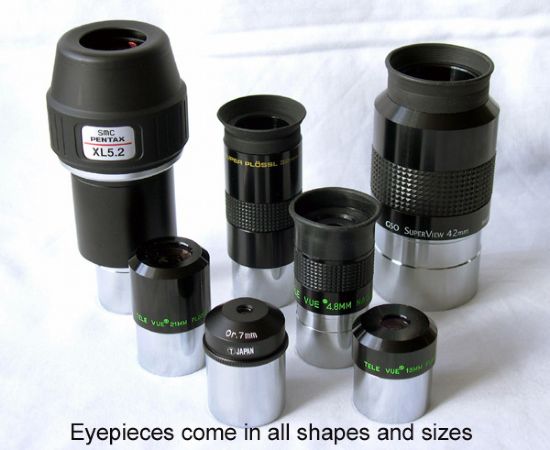
Eyepiece Designs.
There are many different designs of eyepiece, and it can be a little bit confusing deciding which ones you need (or want!). Why are there so many? Why do the prices vary so much? What’s the best for me? Well, there are so many because people like buying eyepieces! The different designs will all do the same job - bring an image to focus for you too see with your eye - but they all have different strengths and weaknesses. The prices vary so much because some eyepieces are produced in hi-tech sterile environments and have rigorous quality control tests applied to them, while others are churned out on a production line in a cheaply staffed factory. Some have a lot more glass than others. Some use rare or exotic types of glass which are more expensive to produce. Some are just plain better than others. As to “What’s the best eyepiece for me?”- That isn’t a question anyone can answer accurately, as it depends on the telescope being used, what type of object you want to observe, how much aberration you can tolerate in the image, your budget and your eye. Here’s a list of the commonly referred to types of eyepieces:
Ramsdens are the simplest type of eyepiece, having only two glass elements inside. They do not show a very flat or sharp image and are extremely limited. They are also very prone to showing false colour. They are best avoided, and are thankfully quite rare now.
Kellners are very similar to Ramsdens though they have one glass element of slightly better quality than the other. They have good eye relief and a wide field of view, but again suffer from poor edge of field performance. There are many types of Kellners still available including some in 2” barrels which make passable wide field eyepieces on a limited budget.
MAs (Modified Achromats) and SMAs (Super Modified Achromats) are modified types of Kellner eyepieces. They have a wide-ish apparent field of view, but they will not show a sharp image across the whole field. They are however cheap!
All of the above types, Ramsdens, Kellners and SMAs, are old eyepiece designs and have been replaced with much more satisfactory designs which give much better images overall:
Orthoscopics (or ‘Orthos’) have four glass elements in two groupings. This allows for much better sharpness across the whole field of view. They show very little (if any) false colour and so would seem to be perfect….except for a couple of caveats. The eye relief on orthoscopics can get very small with short focal length models, which can lead to your eyelash, or even eyeball, touching the glass inadvertently when trying to see the image. The shorter focal lengths are usually best avoided if you have to wear eyeglasses while observing. Also the apparent field of view is a little on the small size, averaging between 42 and 45 degrees. If you can live with these shortcomings then they can provide excellent images and are favoured by planetary observers for the very sharp and high-contrast images they deliver.
Plossls were the next step on the eyepiece evolutionary ladder, and consist of four or five glass elements. The AFOV is usually about 50 degrees, though there are some models with up to 60-degree fields. They are very good workhorse eyepieces with good sharpness, contrast and eye relief, although in short focal lengths this can get a bit on the short side, about the same as in orthoscopics. There are many manufacturers of plossls and many correspondingly different price-points. Budget brands generally provide good images on most telescopes but may suffer in telescopes with short focal ratios. The more expensive brands tend to be tested to work on these ‘faster’ telescopes and so are worth the extra money if you have a telescope with a short focal length.
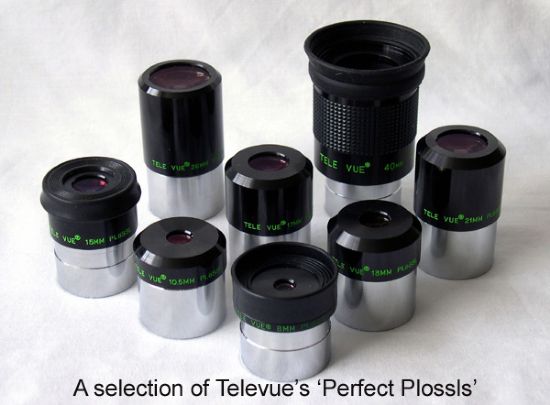
A sub-species is the ‘Super-Plossl’. These are very similar to normal plossls but with some bonuses. The optical coatings on the glass are usually more evenly applied and can allow more light to come through the eyepiece, resulting in brighter images. The edges of the glass lenses may be blackened to cut down on internal reflections, and they usually have rubber grips around the barrel to help people hold onto them in the cold dark nights! These days many standard plossls also have some or all of these features, so it’s worth checking out the exact specifications before buying.
Wide-Field Eyepieces. Eyepieces that have an AFOV wider than a standard plossl are usually referred to as wide-field eyepieces. They can have an AFOV of up to 90 degrees or so, and may contain up to 8 or 9 pieces of glass! Consequently they can be big, heavy and expensive. They can also be superb. As an example a single Televue Nagler eyepiece with an AFOV of 82 degrees can weigh about a pound and cost more than a decent 4” refractor! Not all wide-field eyepieces are that extreme though, and the wide-field market is where the biggest difference between budgets will be noticed.
At the top of the pile (at least in terms of publicity) are the Televue Naglers (82 degree AFOV), Panoptics (68 degrees) and Radians (60 degrees and constant 20mm eye relief). All of Televue’s eyepieces are tested to perform well even in telescopes with a focal ratio (focal length of telescope divided by aperture) of 4, which is a pretty ‘fast’ telescope. This means that they will give consistently sharp images across the field of view and should not present too many edge of field distortions. No eyepiece is perfect for everyone though, and each individual observer’s eye will affect the performance to some degree.
Other excellent manufacturers are Meade, with their ‘Ultra-Wide Angle’ and ‘Super-Wide-Angle’ ranges, and Pentax with their XW range which has just replaced the now discontinued XL models. Meade has just revamped their eyepiece lines, with the UWAs now having an AFOV of 82 degrees and the SWAs having 68 degrees. The new range of Meade plossls actually have a field of 60 degrees, which brings them into direct competition with the Televue Radians. The new Pentax XWs have 70-degree fields, while the older XLs have 65 degrees. Yes, there are a lot of numbers involved, which makes it difficult to compare two eyepieces from different ranges objectively. Generally though, all of these ranges work consistently well with just minor differences across the board, but it’s down at the ‘budget brand’ area of the market where things get a little trickier…
Whereas the top class eyepieces can cost up to £400 new, you can get cheaper wide field eyepieces for as little as £40. Will they perform as spectacularly as the big boys? That can depend on your telescope. In a telescope with a high focal ratio like f8, f10 or higher, the eyepieces are more likely to perform well. It’s when you try and get them to work in your f5 short-tube refractor that they’ll start to perform according to their price. Edge of field distortion will become obvious, and it may be hard to get them to hold focus across the field. In cheaper models the quality control process may not have been applied consistently, so some eyepieces will just not be up to scratch mechanically or optically. In some cases you may actually get more usable sharp field from a good plossl than a substandard wide-field type. But if you can see past these possible defects, or have a long focal length scope and just want a cheap wide-field eyepiece to fit the Double Cluster into occasionally, then a cheaper model produced by Synta, Antares, or similar manufacturers may fit that bill nicely.
Obviously nothing beats looking through the real thing in the flesh to see the differences, but as a cheaper alternative here are some pictures that show the comparative fields of view of the Pleiades as they would appear through our example 4” f10 refractor and a variety of different eyepieces giving similar magnifications:
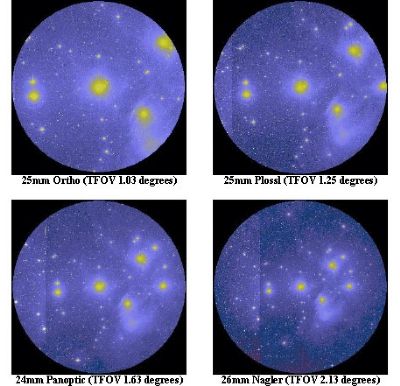
As you can see, that’s quite a difference! The experience of looking through a wide-field eyepiece has been described as being like “taking a space-walk” or “looking through a porthole into space”, and this is not just hype. Our very own Maarten described his first look through a Televue wide-field eyepiece as “Like sticking your head in the telescope”.
My Wide-Field Eyepieces. My currently owned wide-field eyepieces are mostly from two companies at extreme opposite ends of the price divide. They consist of Pentax XLs, which are considered by many to be some of the finest eyepieces produced and were priced accordingly, and GSO Superviews, which cost pocket money. The Pentaxes produce stunning high contrast images across their 65 degree fields, have 20mm eye relief across the range and an adjustable eye cup which can be set to the most comfortable position for your eye. When they were available they sold new for £269 each. I have the 5.2mm, 10.5mm and 14mm models.
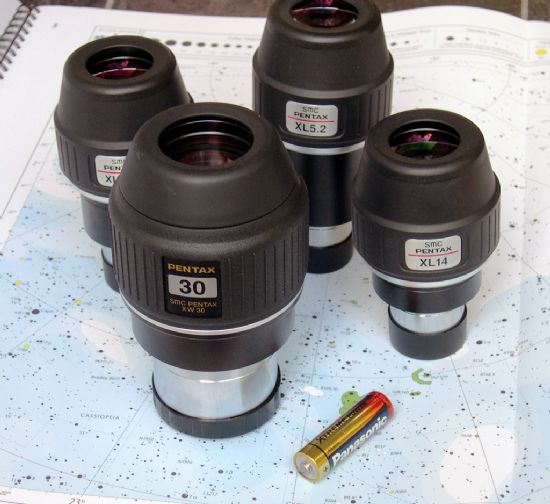
I also own the 30mm XW model, with its 70-degree apparent field of view and trademark 20mm eye relief. You can see it in the picture above, surrounded by its other Pentax relatives. It's quite chunky, but at just over one lb or so is still a lot less heavy than the TeleVue 31mm Nagler type 5 (over 2lb)!
The GSO Superviews are a fairly new range manufactured in Taiwan and distributed mainly in the USA. They come in 2” 30mm and 42mm models And 1.25” 15mm and 20mm versions. They sell for about £35 each (plus shipping and import duty) and their build quality and performance truly belies their price. They do not perform perfectly in ‘fast’ telescopes, but in my f7 refractor they perform very well, with no false colour, good sharpness and tolerable edge of field performance. They are not Panoptics (price £300 ish) but then they don’t cost Panoptic money either. They have an AFOV of between 65 and 68 degrees, so are noticeably wider than plossls that may well cost more money. This company also produces a fine set of standard plossls which also receive favourable reviews. I have a 9mm model which came with my GSO Dobsonian reflector, and it is a fine plossl - very similar to Meade Series 4000 plossls I have owned.
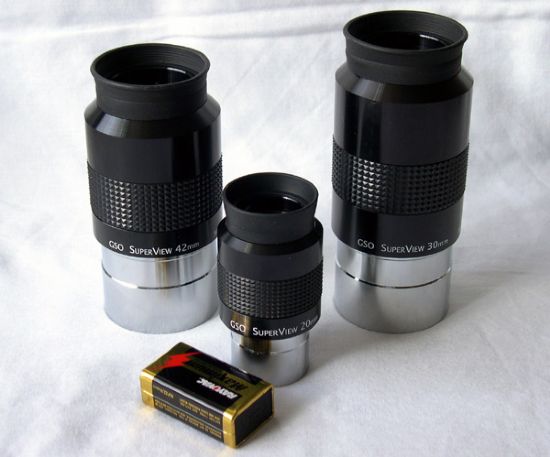
Click here to go to part 3, Buying Eyepieces